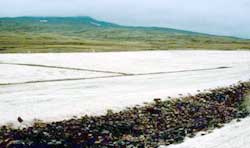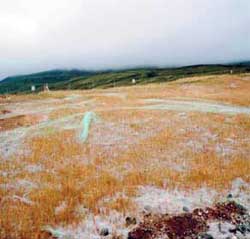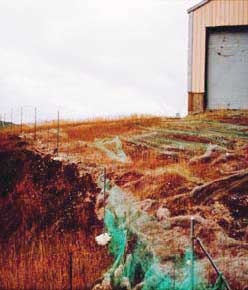Chapter 10: Mulch and Erosion Matting
When deciding on the use of a mulch, such as straw or an erosion matting, several factors should be considered; erosion potential due to wind or water is the first consideration. If the soil does not have a high erosion potential, then mulch and/or matting should be skipped.

Figure 76: Well-placed excelsior blankets being used to control erosion prior to vegetation growth.

Figure 77: Damage to an excelsior blanket product when used in severe wind areas. The plastic backing separated from the wood fiber and created a non-degradable mess capable of entrapping small wildlife.
The second consideration is cost. Application of mulch and matting add significant costs to a project; not only in materials, but also in labor.
The third consideration is safety. Sections of netting may come loose and cause hazards to wildlife and property.

Figure 78: The plastic web or backing has created traps that have ensnared birds and fish - the use of this product should be carefully considered and based on true need and area of use, considering potential consequences.
A final concern is that straw may introduce unwanted weeds.
The above concerns do not apply to wood and paper fiber or similar products used in hydroseeders. When hydroseeders are used, mulch is standard. The mulch fiber forms a slurry that acts as a carrier for the seed and fertilizer. Without the mulch, seed and fertilizer would not suspend in solution and uniform distribution would be impossible. The mulch also marks the area that has been treated.
Table 4. Mulch and Netting Comparison Chart
|
Mulch/
Netting
Type |
Difficulty In Using
Correctly |
Erosion Resistance
(Relative) |
Cost
(Relative) |
Cost to Apply
(Relative) |
Environment Restrictions for Use |
Soil Type Where Most Effective |
Wood or
Paper Fiber
Mulch |
No |
Low |
Low |
Low |
Few |
All |
Straw
Mulch |
No |
Medium |
Low |
Moderate |
High Winds Hamper Use |
Fine Grain |
Jute Mesh -
Type Netting |
Yes |
Medium |
Moderate |
High |
None |
Course Grain |
Tack Netting |
Yes |
Low |
Moderate |
High |
None |
Course Grain |
Excelsior -
Type Blankets |
Yes |
High |
High |
High |
Plastic Netting
Can Be a Problem |
All |
Chemical Stabilizers |
No |
Varies |
Varies |
Low |
Temperature Requirement
For Application |
Course Grain |
|